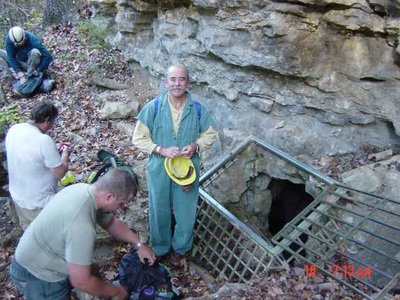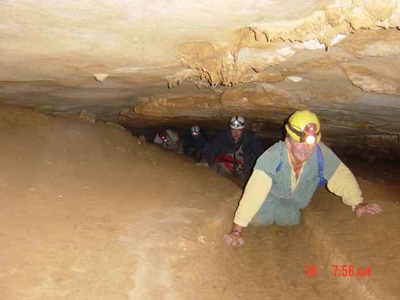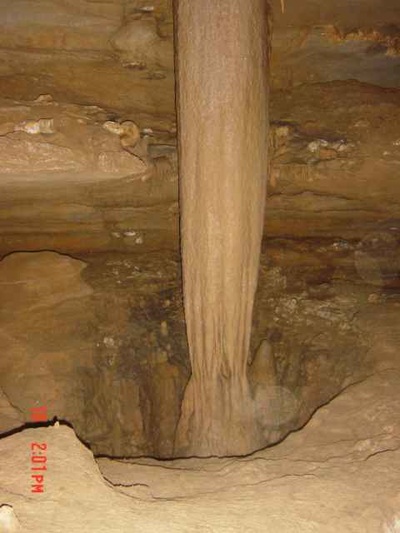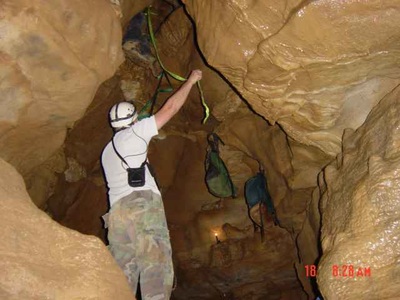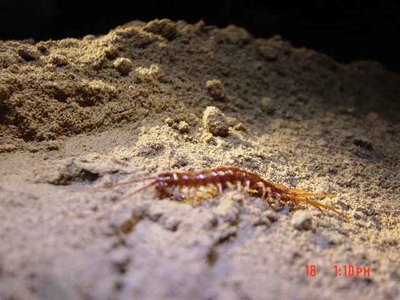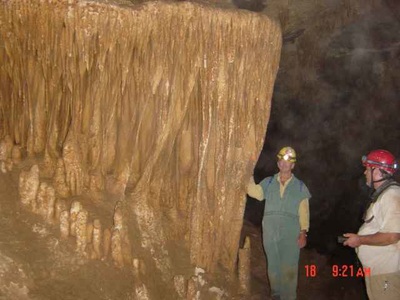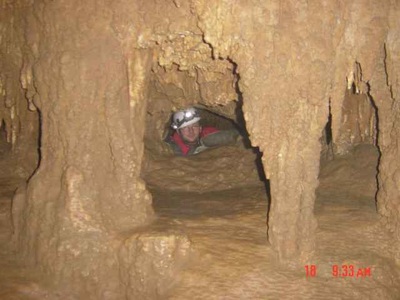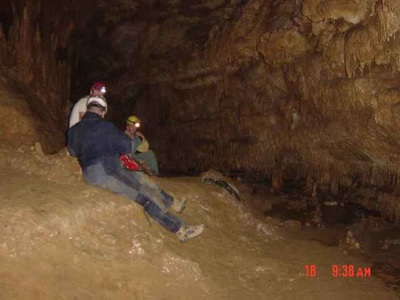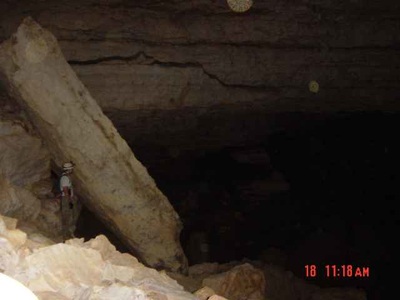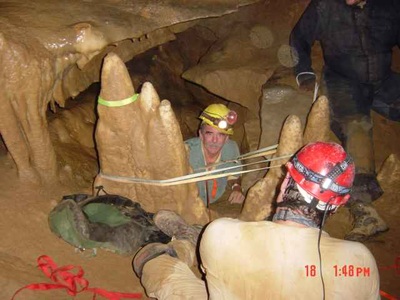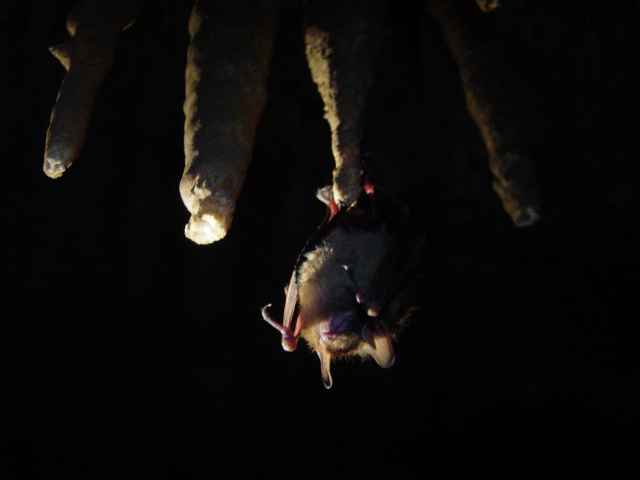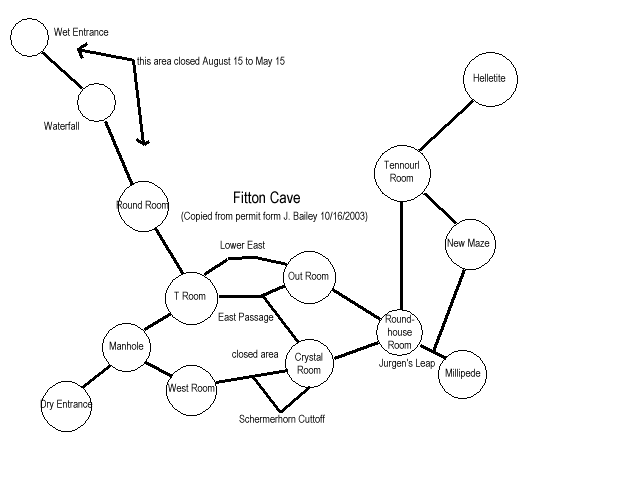Fitton Cave Report by Josh Bailey
Fitton Cave has to be about the biggest cave, I've been in, in the US. Our party of Alf and Wade (who led us), Wes, Ray and myself, all hiked in from Compton, Arkansas, early on the morning of Saturday the 18th. From the trailhead it was perhaps half an hour, down Cecil Creek (very low and almost dry - when in full flow the waterfalls and stream bed would've been beautiful). Then we crossed the property of an old homestead, crossed the Creek itself and up a small ravine and a very short scramble to the entrance grate.
Wade unlocked the grate while we all prepared our gear. Quite a lot of warm, humid air was coming out of the entrance (we noticed quite a breeze up to the T-room, described later). Inside the cave, it was down a way into the large Entrance Room, of football-field dimensions, with a large number of centrally located (though dead) formations, mostly columns and stalagmites. From there, we proceeded down, then along a crawl called (variously) the Monorail Crawlway - easily navigated by placing one's knees either side of the central grove and crawling conventionally along. We passed then the Missile Silo, an interesting column perhaps 20 feet high, extending into holes both in the roof and in the floor.
Our next way point was the Manhole - rather unremarkably situated in a side alcove (in fact, we went past it altogether at our first attempt). The Manhole is one of the prime injury prone sites in the cave, so we took our time rigging our way down it (approximately 10 feet, perhaps free-climbable down, but very slick indeed climbing out again without help). Carefully we took another crawl (over a crack in the floor that paralleled the direction of the crawl), to a junction that eventually opened into welcome walking passage (of which most of the cave was composed as we found).
From there, we proceeded over and under breakdown through very substantially-sized passages, to the next big room - the T-Room (passing a high-up red survey flag which we marvelled at, and a small stream in which we looked for salamanders and found one small one). The T-Room is where the cave's first major split was, off towards the "wet" entrance (closed this time of year), including a 50 foot waterfall and the infamous 21 Jumps passage. We proceeded through this room along more long galleries (observing many bats), each of us tending to find our own ways across the breakdown or up and along walls (my preference). A recurring theme seemed to be 15-20 foot high dams of earth and rock that partitioned off sections of the galleries that needed to be scaled (or walked across to, along shelves extending from the walls).
Eventually we made it to the Eye of the Needle, another known injury-prone site. There is a slippery scramble up 8 feet or so up slick rock, then a small squeeze - the Needle itself. On the other side of this we paused for lunch, having made a lot of progress.
Our next target was the Out Room. This was reached after a good deal more rock scrambling and climbing. The Out Room itself was unevenly filled with breakdown, making it difficult to see from our entry way, exactly where the exit was. The Out Room was again an Entrance-room sized space. Up we climbed, perhaps 100 feet in elevation up a steep slope of breakdown and then along a high and wide shelf, to eventually reach the Round-House Room - truly gigantic. Our flashlights struggled to reach the other side of the Room from our high viewpoint. My camera flash certainly did not make it. I would say the Round-House Room would be easily the largest of all we encountered. We decided to pause and then head back here, some of our party tiring and our objective having been exceeded (we'd hoped to've got to at least the Out Room).
Our next target was the Out Room. This was reached after a good deal more rock scrambling and climbing. The Out Room itself was unevenly filled with breakdown, making it difficult to see from our entry way, exactly where the exit was. The Out Room was again an Entrance-room sized space. Up we climbed, perhaps 100 feet in elevation up a steep slope of breakdown and then along a high and wide shelf, to eventually reach the Round-House Room - truly gigantic. Our flashlights struggled to reach the other side of the Room from our high viewpoint. My camera flash certainly did not make it. I would say the Round-House Room would be easily the largest of all we encountered. We decided to pause and then head back here, some of our party tiring and our objective having been exceeded (we'd hoped to've got to at least the Out Room).
The trip back was uneventful and safely navigated with only a couple of wrong turns, easily corrected through the extensive experience of our party. The Manhole spared us any injury or inconvenience thanks to our fortuitous choice of gear.
Fitton Cave has 8 miles of passage known as of the 1970's, with very many more suspected. The entire trip was 7 hours (inside the cave), 4 hours in, 3 out. I would welcome a return to Fitton Cave. My objective for my next trip would be to go well beyond the Round-House Room to the true "back" of the cave which is reputedly highly decorated., hopefully including a loop through to the West Room. Though, I'd consider myself lucky to try the wet entrance too.
